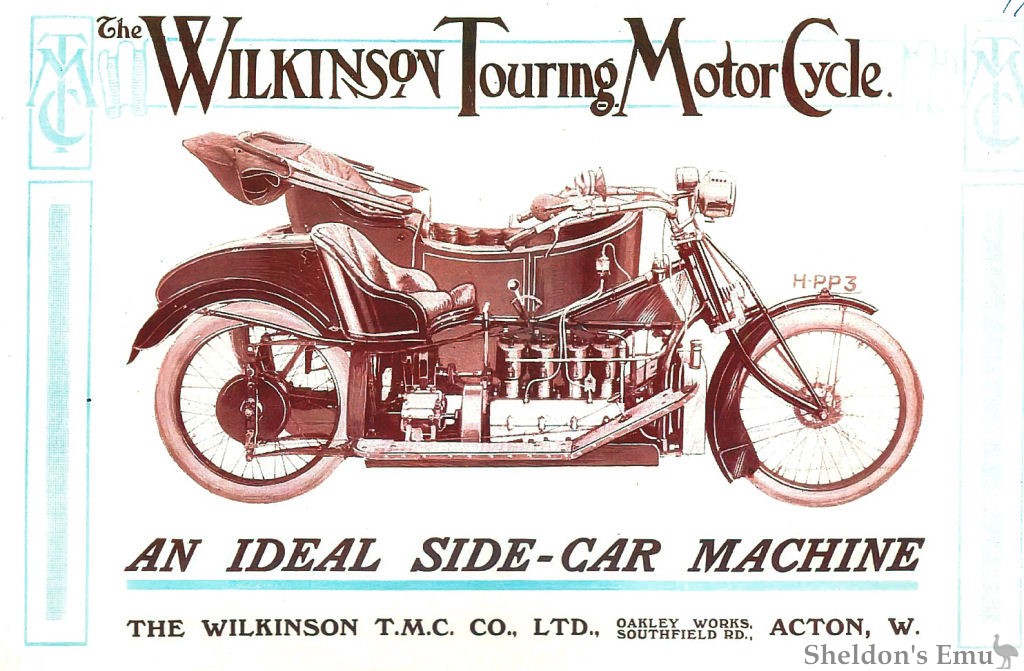



A Brief History of the Marque
Wilkinson Sword produced motorcycles from 1903 to 19051 and then from 1908 to 1915, first in Chelsea and then in Acton, London.
TMC, the initials of Touring Motor Cycle, was a motorcycle produced from 1912 to 1915, by Wilkinson, of Acton in London.
This was the name adopted for their four-cylinder, three-speed, shaft-drive luxury machine that had suspension for both wheels and a bucket seat for the rider.
Initially the machine was sold as the Touring Auto-Cycle, or TAC, but it soon became better known by the company name of Wilkinson.
Wilkinson Sword de Acton, Londres era una empresa que comenzó en 1772 haciendo espadas, sables y cuchillos (y en los últimos 100 años continuó produciendo máquinas de afeitar y equipo de jardín) pero cada vez que vieron la oportunidad (principalmente en épocas de paz, donde necesitaban mantener ocupados sus talleres) diversificó su producción y fue así que a partir de 1903 y hasta 1916 fabricó motocicletas.
Después de un primer modelo con motor monocilíndrico Antoine que tuvo poco suceso en 1903, Wilkinson desarrolla en 1908 la primera moto con fines comerciales. Diseñada por P. G. Tacchi como un modelo para exploración militar, tenía un motor V-twin y montaba en el manillar una ametralladora Maxim fabricada por la misma Wilkinson. Presentada a los militares británicos en el verano de 1908, la motocicleta no logró impresionar a las autoridades y entonces la fábrica optó por convertirla en una versión de lujo para uso civil.
Así es como un año más adelante se exhibió una nueva versión en el Stanley Show de Londres. Ahora el modelo llamado T.A.C. (Touring Auto Cycle) llevaba un motor de cuatro cilindros en línea de 678 cc. con válvulas de admisión automáticas y refrigerado por aire. El carburador era Amac, el magneto Simms, la caja de cambios era de tres velocidades y la transmisión por eje y sinfín a la rueda trasera. La horquilla delantera inicialmente era Chater-Lea pero pronto fue cambiada por otra diseñada por Wilkinson. La rueda trasera estaba soportada por cuatro elásticos elípticos de un cuarto de vuelta. El tanque de combustible estaba colocado en el guardabarros trasero y podía estar equipado a pedido con un volante de dirección en lugar del convencional manillar, lo que junto con el asiento tipo butaca eran una extraordinaria innovación para la época. Para el show de 1910 presentan dos modelos, incorporando uno con motor de 550 cc. y reemplazando el magneto por un Bosch y el carburador por un Brown & Barlow.
A fines de 1911 se presenta el modelo T.M.C. (Touring Motor Cycle). La motocicleta Wilkinson ahora tenía un motor de 848 cc, válvulas laterales, refrigerado por bomba agua con el tanque en la parte superior y con un radiador grande al frente. Un cárdan con engranaje cónico reemplazó el mecanismo de gusano sinfín del modelo original y con la caja de cambios de tres velocidades alcanzaba los 80 km/h. El carburador era un Stewart Precision y la horquilla diseñada por Wilkinson fue actualizada con una Druids para mejorar el manejo.
Con el comienzo de la Primer Guerra Mundial, Wilkinson volvió a hacer sables y bayonetas y vendió sus proyectos automotores a la Ogston Motor Company, que discontinuó el TMC en 1916. Solamente cerca de 250 Wilkinson fueron producidas, pero terminada la guerra esta fábrica usó el mismo motor en un auto liviano: el Ogston Deemster.
1908 The first machine was originally designed as a military scouting model by P. G. Tacchi, who was granted patent rights in 1908. The machine, mounting a lightweight, quick-firing Maxim gun, did not impress the authorities and Wilkinson carried on with a luxury touring version.
1909 This luxury machine was built by the firm that was already famous for swords, bayonets (and later for razor blades and garden tools). The motorcycle was long and had an in-line four-cylinder engine, clutch, three-speed gearbox and shaft-drive to a worm at the rear wheel. engine capacity was 678cc, the crankcase cast-iron and split horizontally, the drive from clutch to gearbox by spring steel to absorb shocks, and starting by hand lever. To begin with, Chater-Lea leading-link forks were used, but these were soon changed to a Wilkinson design. The rear wheel was supported by four quarter-elliptic springs. The oil tank went just behind the headstock, but the petrol tank was placed on the rear mudguard and the rider was provided with a bucket seat. This machine was listed as the Touring Auto-Cycle or TAC.
1909 Late in the year, the TAC started to appear with the fitment of a steering wheel.
1910 The TAC was advertised as having a steering wheel.
1910 Cycle and Motorcycle Exhibition
Wilkinson T.A.C. Co., Ltd.
London, S.W. Stand No. 33.
Those motorists who are of opinion that the best results are only to be obtained from a multi-cylinder engine, whether it be used in conjunction with a car or a cycle, will be
interested in this firm's 1911 models, for Messrs. Wilkinson and Co. are one of the very few who place a four-cylindered motor-cycle upon the market. And the " Wilkinson" motor-
cycle has very many up-to-date points to command attention, not the least being the three-speed gear box and leather cone clutch. The petrol tank, fitted over the rear mudguard,
is of sufficient capacity to carry the rider for at least two hundred miles. The magneto is very conveniently situated, and is carried upon a special bracket. The brake work has
evidently received special attention, internal expanding brakes being employed for both wheels. The front wheel brake is controlled by Bowden wire from the handlebar, whilst the
rear brake is brought into action by the depression of a pedal connected thereto by cable wire. All the control levers are conveniently placed upon the handlebar. The engine, it
should be noted, can be started from the driver's seat. It is noticeable that various minor improvements and modifications have been introduced into the new model, and it must be
admitted that the "Wilkinson," in many ways, shows a distinct advance in motor-cycle design and construction. There are two models shown, one being practically a replica of the
other, but more elaborately finished, whilst the H.P. of both is optional, either a 5-6 H.P. or 6-7 H.P. motor being fitted, as desired.
1911 The engine size became 550cc for one model that had mechanical inlet-valves. Handlebars returned.
1912 The capacity went up to 848cc and, originally air-cooled, the engine was redesigned as a water-cooled unit. The Bosch magneto was mounted on top of the gearbox and thus under the seat. Bevel drive replaced the worm at the rear axle, and Druid forks replaced the leading links. The name was changed to the Touring Motor Cycle or TMC.
1913 The TMC was only sold as a sidecar outfit, and a brief link with the Wooler Engineering Co was reported.
1914 Both solo and sidecar versions were offered and, during the year, manufacture was taken over by the Ogston Motor Co Many detail improvements were made.
1915 The Wilkinson was still listed as 848cc using bevel drive, and as 1087cc with worm drive - both with three-speed gearbox. The power unit returned after the War in the December car but the motorcycle was a casualty of the war.
Notes
1. See Wilkinson-Antoine
Sources: Graces Guide, Sergio Scalarandi
If you have further information or a query related to this page, please contact us